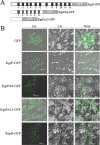Ketoglutarate transport protein KgtP is secreted through the type III secretion system and contributes to virulence in Xanthomonas oryzae pv. oryzae
- PMID: 22685129
- PMCID: PMC3406143
- DOI: 10.1128/AEM.07997-11
Ketoglutarate transport protein KgtP is secreted through the type III secretion system and contributes to virulence in Xanthomonas oryzae pv. oryzae
Abstract
The phytopathogenic prokaryote Xanthomonas oryzae pv. oryzae is the causal agent of bacterial leaf blight (BB) of rice and utilizes a type III secretion system (T3SS) to deliver T3SS effectors into rice cells. In this report, we show that the ketoglutarate transport protein (KgtP) is secreted in an HpaB-independent manner through the T3SS of X. oryzae pv. oryzae PXO99(A) and localizes to the host cell membrane for α-ketoglutaric acid export. kgtP contained an imperfect PIP box (plant-inducible promoter) in the promoter region and was positively regulated by HrpX and HrpG. A kgtP deletion mutant was impaired in bacterial virulence and growth in planta; furthermore, the mutant showed reduced growth in minimal media containing α-ketoglutaric acid or sodium succinate as the sole carbon source. The reduced virulence and the deficiency in α-ketoglutaric acid utilization by the kgtP mutant were restored to wild-type levels by the presence of kgtP in trans. The expression of OsIDH, which is responsible for the synthesis of α-ketoglutaric acid in rice, was enhanced when KgtP was present in the pathogen. To our knowledge, this is the first report demonstrating that KgtP, which is regulated by HrpG and HrpX and secreted by the T3SS in Xanthomonas oryzae pv. oryzae, transports α-ketoglutaric acid when the pathogen infects rice.
Figures






Similar articles
-
GamR, the LysR-Type Galactose Metabolism Regulator, Regulates hrp Gene Expression via Transcriptional Activation of Two Key hrp Regulators, HrpG and HrpX, in Xanthomonas oryzae pv. oryzae.Appl Environ Microbiol. 2016 Jun 13;82(13):3947-3958. doi: 10.1128/AEM.00513-16. Print 2016 Jul 1. Appl Environ Microbiol. 2016. PMID: 27107122 Free PMC article.
-
Identification of phenolic compounds that suppress the virulence of Xanthomonas oryzae on rice via the type III secretion system.Mol Plant Pathol. 2017 May;18(4):555-568. doi: 10.1111/mpp.12415. Epub 2016 Jul 1. Mol Plant Pathol. 2017. PMID: 27084974 Free PMC article.
-
Fructose-bisphophate aldolase exhibits functional roles between carbon metabolism and the hrp system in rice pathogen Xanthomonas oryzae pv. oryzicola.PLoS One. 2012;7(2):e31855. doi: 10.1371/journal.pone.0031855. Epub 2012 Feb 22. PLoS One. 2012. PMID: 22384086 Free PMC article.
-
Molecular determinants of disease and resistance in interactions of Xanthomonas oryzae pv. oryzae and rice.Microbes Infect. 2002 Nov;4(13):1361-7. doi: 10.1016/s1286-4579(02)00004-7. Microbes Infect. 2002. PMID: 12443901 Review.
-
Rice Routes of Countering Xanthomonas oryzae.Int J Mol Sci. 2018 Oct 2;19(10):3008. doi: 10.3390/ijms19103008. Int J Mol Sci. 2018. PMID: 30279356 Free PMC article. Review.
Cited by
-
Type III chaperones & Co in bacterial plant pathogens: a set of specialized bodyguards mediating effector delivery.Front Plant Sci. 2013 Nov 22;4:435. doi: 10.3389/fpls.2013.00435. Front Plant Sci. 2013. PMID: 24319448 Free PMC article. Review.
-
Identification of 17 HrpX-regulated proteins including two novel type III effectors, XOC_3956 and XOC_1550, in Xanthomonas oryzae pv. oryzicola.PLoS One. 2014 Mar 27;9(3):e93205. doi: 10.1371/journal.pone.0093205. eCollection 2014. PLoS One. 2014. PMID: 24675748 Free PMC article.
-
Comparative genomics and pathogenicity potential of members of the Pseudomonas syringae species complex on Prunus spp.BMC Genomics. 2019 Mar 5;20(1):172. doi: 10.1186/s12864-019-5555-y. BMC Genomics. 2019. PMID: 30836956 Free PMC article.
-
Transcriptomic analysis of Phytophthora infestans races and evaluation of their pathogenicity on potato.BMC Plant Biol. 2025 May 28;25(1):716. doi: 10.1186/s12870-025-06736-y. BMC Plant Biol. 2025. PMID: 40437352 Free PMC article.
-
HrpE3 is a type III effector protein required for full virulence of Xanthomonas oryzae pv. oryzicola in rice.Mol Plant Pathol. 2013 Sep;14(7):678-92. doi: 10.1111/mpp.12039. Epub 2013 May 14. Mol Plant Pathol. 2013. PMID: 23672717 Free PMC article.
References
-
- Akimoto-Tomiyama C, et al. 2012. XopR, a type III effector secreted by Xanthomonas oryzae pv. oryzae, suppresses microbe-associated molecular pattern-triggered immunity in Arabidopsis thaliana. Mol. Plant Microbe Interact. 25:505–514 - PubMed
-
- Alfano JR, Collmer A. 2004. Type III secretion system effector proteins: double agents in bacterial disease and plant defense. Annu. Rev. Phytopathol. 42:385–414 - PubMed
-
- Arwas R, McKay IA, Rowney FRP, Dilworth MJ, Glenn AR. 1985. Properties of organic acid utilization mutants of Rhizobium leguminosarum strain 300. J. Gen. Microbiol. 131:2059–2066
Publication types
MeSH terms
Substances
LinkOut - more resources
Full Text Sources
Other Literature Sources

